by Siddharth Singh Bhaisora
Published On Oct. 19, 2023
Understanding the seasonal pattern in the stock market is crucial for traders aiming to optimize their returns. Seasonality in the stock market refers to the recurring trends and patterns that are observed during specific periods within the year. These patterns are identified based on historical data, and while they don't guarantee future performance, they do provide insights into potential market movements.
And stock markets around the world have shown repetitive trends and seasonality patterns at specific times during a year.
A famous seasonal stocks pattern in the US, where financial markets follow the calendar year, is the "January effect," showing stocks typically performing better in January due to factors like tax-loss harvesting in December
Another is the "Santa Claus rally," where stocks rise during the last part of December.
Similarly we see a March to May effect when markets again do well.
Seasonal stocks in India are those that experience fluctuations in demand and performance based on specific times of the year, driven by seasonal trends and events. These seasonal stocks are influenced by factors such as festivals, agricultural cycles, weather conditions, and holiday seasons. For instance, retail and consumer goods companies often see a surge in sales during the festive periods like Diwali and Christmas, making them prime examples of seasonal stocks in India. Similarly, agricultural stocks might perform better during the monsoon season due to increased farming activities, highlighting another category of seasonal stocks in India. But why is this? Why are there seasonal stocks patterns to investing in stock markets? What is the October effect for Indian stock markets?
Understanding the patterns of seasonal stocks in India allows investors to capitalize on cyclical opportunities, optimizing their investment strategies to benefit from predictable changes in market demand and stock performance. We will first look at global trends and patterns and then jump into how these patterns show up for Indian stock markets, and ultimately what this means for you as an investor.
Stock market tends to perform better between November and April compared to the period from May to October - this is known as the “Sell in May, Buy in October” effect. Research conducted across 14 countries over 2000 to 2015 reinforces this observation.
Average Sum of Monthly returns from 2000 to 2015 across countries globally
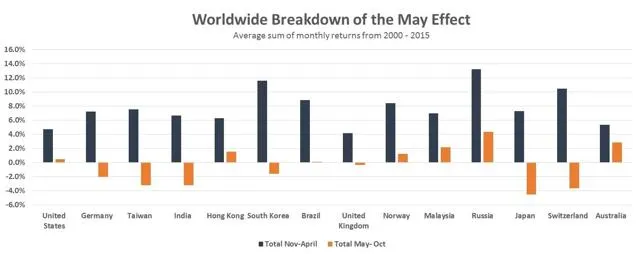
While there's a distinct variation between countries, the overarching trend shows better and higher returns from November to April compared to May to October. For instance, the S&P index showcases a significant discrepancy in returns, with the November-April period outperforming the May-October period by over 10 times. The possible reasons behind this phenomenon have been attributed to reduced trading volumes during summer vacation months and increased investment flows during the winter months which also have several key festivals across major religions along with a year end and beginning of a new year both from a calendar and a financial market perspective.
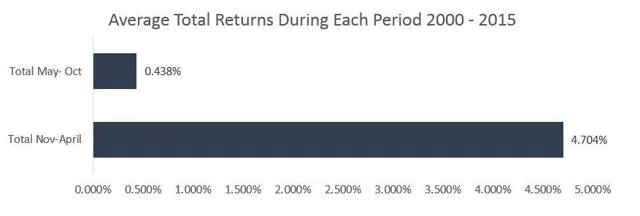
Knowing that some months tend to be weak or strong on average can help traders and investors make more informed decisions. For instance, a long only trader might be more cautious during historically weak months. Another instance could be that in historically weaker months there could be potential buying opportunities for the buy-and-hold investor allowing them to profit via a buy low and sell high strategy. So, here are the average monthly returns for the period 2000 to 2015 for S&P 500.
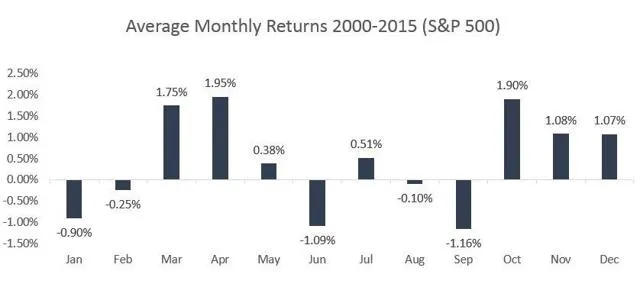
As we can see there are 3 very poor months - January, June and September. February and August also don’t do well. However, there appears to be significantly better performance and better monthly returns for stock markets in March, April, October, November and December.
When we look at a wider window, we see that historically, September has been a challenging month for the stock market, especially the S&P 500. Here’s an analysis that shows the performance of a $1,000 investment over time, segmented by month. If an investor only put their money into the S&P 500 during September from 1960 to 2022, their investment would have decreased by 40%, resulting in a value of $600. This contrasts with other months like October, where the same approach would lead to an increase of 79%, resulting in a value of $1,785. November and December tend to show higher returns during the period for the S&P 500 compared to September and October.
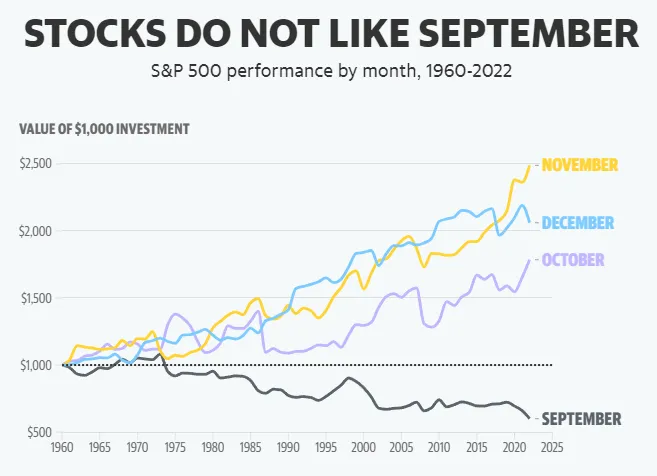
There can be a lot of reasons to explain September’s performance such as many large-scale investors rebalancing their concentrated portfolios after the summer, lead to potential market volatility , end of summer break for families etc. There have also been several significant market events, such as Black Monday in 1987, the 9/11 attacks in 2001, and the Lehman Brothers collapse in 2008, many of which have occurred during September and October. The Israel-Palestine war also started recently and its impact on stock markets can be seen here . These events can significantly skew the performance data for these months.
S&P 500 performed strongly until July but saw declines in August. In such years, the historical data suggests a more bullish trend in the latter months for November to December. This can be seen in the statistics where, for example, November has shown a 73% positive rate with an average gain of 2.5%.

Looking at seasonal stocks patterns across a 20 year period, here are the best months to buy stocks and the worst months for stock markets across the US.
Seasonal Stocks Patterns – Best and Worst Months for the Stock Market, Summary Table (20-year averages)
Up Months | Weak Months | Best 3 Months | Worst Months | |
NYSE Composite | March, April, May, July, October, November, December | January, February, June, August, September | April, July, November | January, June |
S&P 500 | February March, April, May, July, August, October, November, December | January, June, September | April, July, November | January |
Nasdaq 100 | January, March, April, May, July, August, October, November, December | February, June, September | April, July, October/November | June, September |
As we can see November is one of the best months for US stock markets and in the up months we see December also does well.
Want to know All About Alpha: Is Your Investment Generating Alpha?
Well it appears that the best month to buy stocks in India is in line with the performance we see during October, November and December. Now, this performance varies depending on the time period we are looking at for the Indian stock markets. Let’s look at it in depth and see if we can figure out the best month to buy stocks in India.
Here is a detailed analysis that was conducted by Jayen Patel for the International Business & Economics Research Journal in March 2008, where he studied monthly returns for NSE 500 and BSE 500 for the period 1999 to 2007. Both the BSE 500 and NSE 500 indexes exhibit significantly higher returns in the months of November and December compared to the rest of the year. October sees a slight dip for both indices with monthly average returns picking up in November (8.55%) and December (6.40%). Surprisingly, March seems to be one of the worst times to invest, this could be on account of a new union budget being announced and its impact on Indian stock markets - a topic for another day.
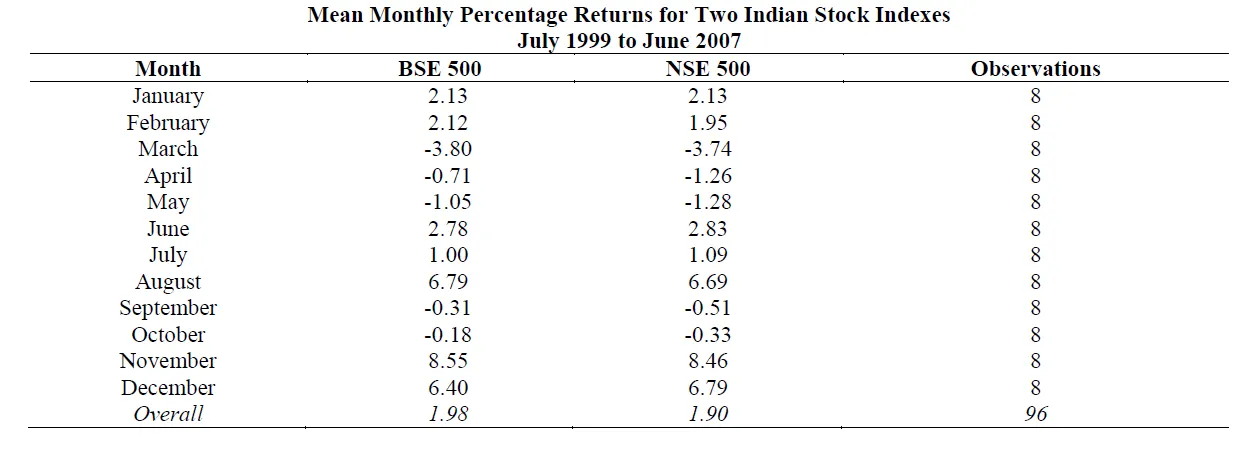
The difference in returns for the November to December months and the rest of the year is a statistically significant result i.e. this finding is real, reliable, and not randomly based on chance or luck. The T-test (a parametric test) and the Mann-Whitney test (a non-parametric test) both confirm that the differences in returns between these periods are statistically significant. We can see this in the table below:

Let's look at historical data to figure out the best month to buy stocks in India. Over the last 10 years, the Nifty index has predominantly shown a positive trend in October, showing gains 9 times out of 10. On average, October has delivered a return of ~3%.
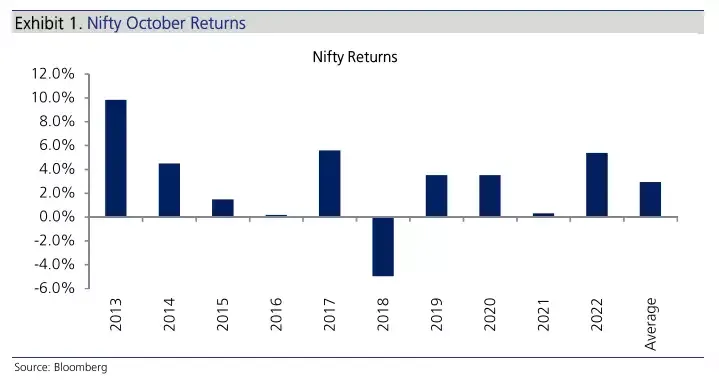
Nifty Midcap index has also displayed a 100% positive track record in the past decade, with an average return of 3.3%. Nifty Bank and Nifty Financial indices have also consistently ended positively in October, boasting impressive average returns of 6.2% and 5.4%, respectively. Indices like Nifty Metal, Auto, and Energy have shown positive returns in October when we look at 8 out of the last 10 years. It is clear that thebest month to buy stocks in India is during October, November and December.
The observed patterns in the Indian stock market returns from slightly negative or low performance in October to strongly positive and some of the highest across the calendar months in November and December can be attributed to several economic and societal events that occur in the Indian calendar.
The month of October marks the beginning of the festive season with Onam, Navratri and other festivals. As we move into November, the festive season picks up with Diwali. All of this is culturally significant but has an impact on Indian stock markets. This is because the festive period is expected to potentially drive market momentum on the back of increased consumption spending. From purchasing items for the household to usher in the new year to receiving bonuses, all of this could contribute to increased liquidity and investment in Indian stock markets. Whether there is indeed a diwali effect on Indian stock markets is something that we will cover in our next set of articles.
Additionally, Q2 earnings season with insights and forecasts from company management regarding demand, margin profiles, and potential challenges due to raw material prices will be keenly observed by market participants.
Ben Jacobsen and Cherry Y. Zhang analyzed data across 108 countries and found similar results, along with other known economists when researching the October effect. They looked at the UK stock market over different time periods, going as far back as 300 years and applied the October effect (Halloween effect) strategy.
In this chart, the dark solid line represents the Halloween effect. The dotted lines (L95B and U95B) indicate the 95% confidence interval based on Newey-West standard errors. It's evident that there are periods when the effect is stronger and periods when it's weaker or even negative. And it is negative during the 1940s period probably on account of World War II and the exit of the UK from India being 2 events that happened during that decade for the UK stock market.
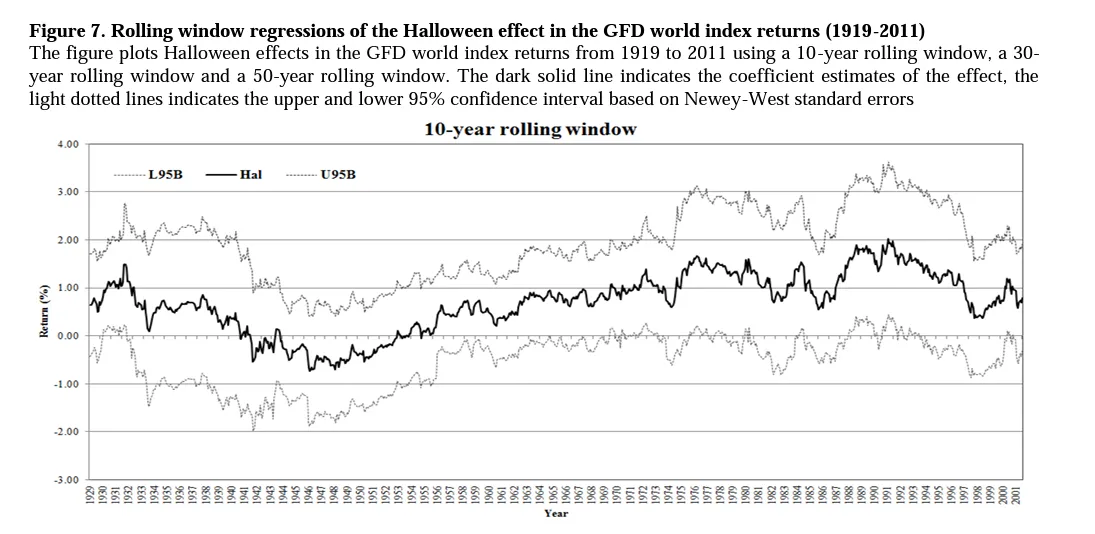
Here, the Halloween effect, represented by the dark line, shows more stability due to the longer time window considered. It's clear that, especially in the earlier years, the Halloween effect was less pronounced, but it seems to pick up from the 1970s onwards.
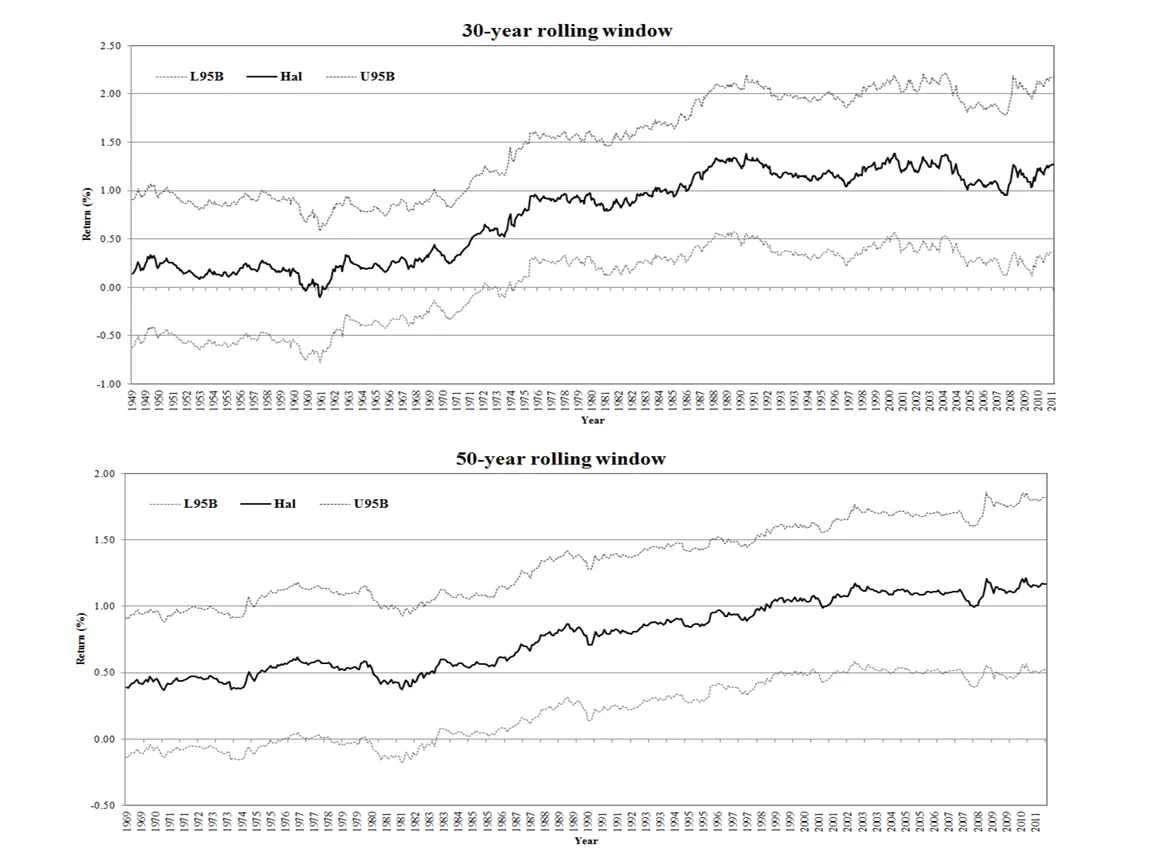
This graph provides the broadest perspective, smoothing out short-term fluctuations. Similar to the other windows, it shows that the Halloween effect seems to be consistent over time. The first half of the 20th century does show a weaker halloween effect, with it picking up strength as we move towards the 21st century. They continued the analysis with a 100 year rolling window going as far back as 1793 till 2009 and found similar results.
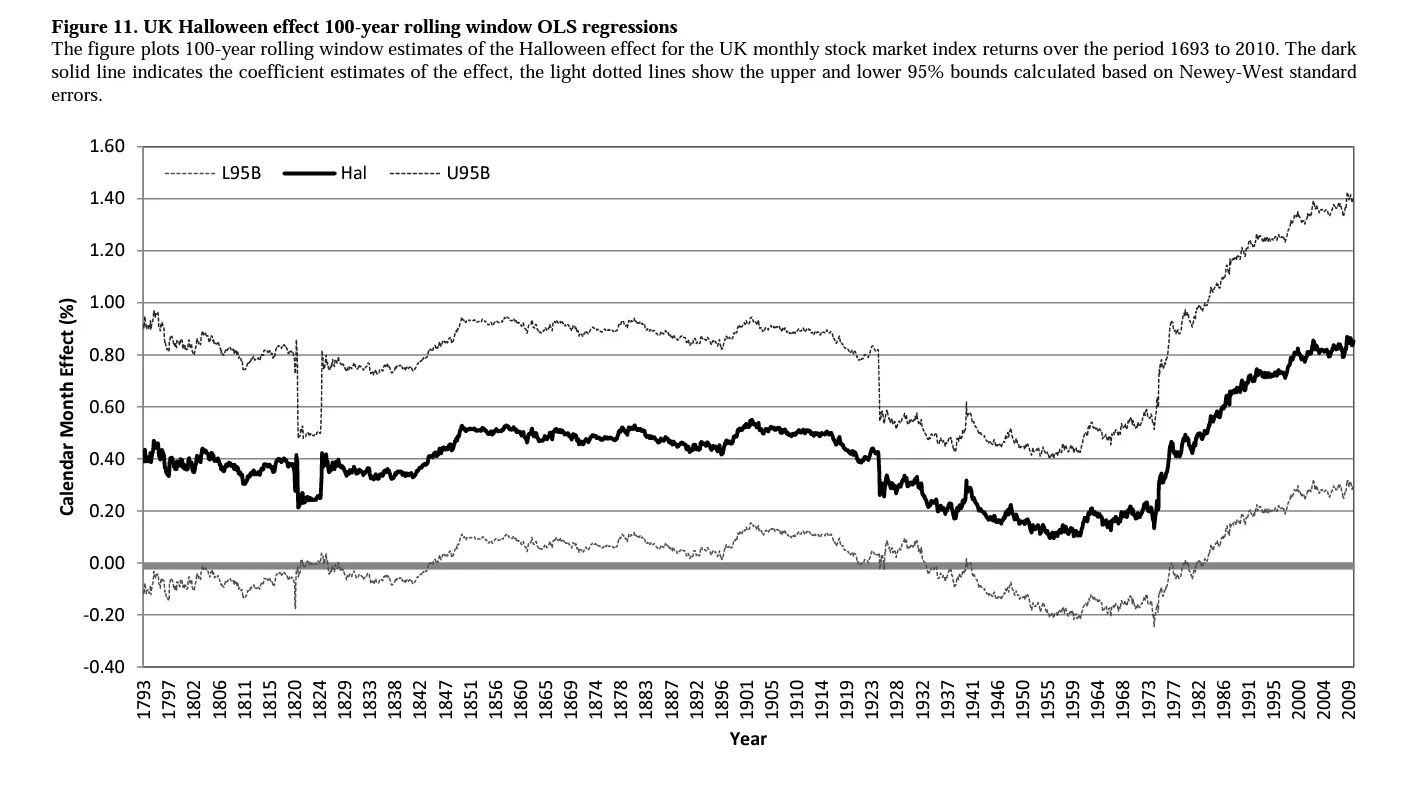
They find consistent outperformance of a 6-month switching strategy (referred to as the "Halloween" effect) compared to a standard buy and hold approach. The plots reveal that the Halloween strategy yields fewer extreme negative returns and more extreme positive returns than the buy and hold approach.
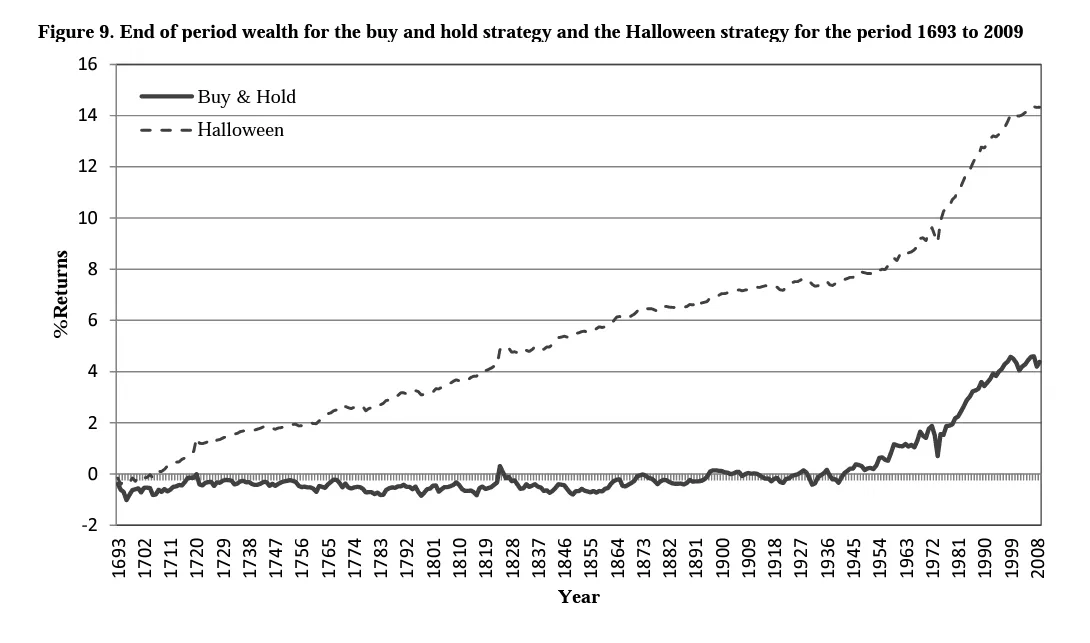 Higher Average Returns for October Effect
Higher Average Returns for October EffectAcross all horizons, the Halloween strategy consistently yields higher average returns than the buy and hold strategy — about 3x higher.
Excluding the 1 year horizon, the maximum returns of the Halloween strategy consistently exceed those of the buy and hold approach, and the latter always has lower minimum returns.
The Halloween strategy generally outperforms the buy and hold strategy. The longer the investment horizon, the higher the likelihood of the Halloween strategy outperforming the market; 91.56% for a 10 year horizon.

The standard deviation, a measure of market volatility , differs depending on the horizon. For shorter horizons, the Halloween strategy has lower volatility, but as the investment horizon increases, its volatility surpasses that of the buy and hold strategy.
The higher standard deviation for longer horizons in the Halloween strategy is attributed to positive skewness, implying more extreme positive returns compared to the buy and hold strategy.
This is a favorable characteristic, suggesting that large gains are more frequent than large losses.
Interestingly, one might hypothesize that countries in the Southern Hemisphere, which experience winter during the Northern Hemisphere's summer months, might display a reverse trend. There seems to be no visible inversion in effect based on hemispheric differences. All the studied indices, regardless of geographical location or specific index type, exhibited this October or May effect.
Want to know All About Alpha: Is Your Investment Generating Alpha?
Several theories explain the existence of these seasonal stocks patterns. One is the economic seasonality concept, suggesting industries like retail and tourism booming during certain seasons, influencing the stock market positively. The holidays, for instance, boost consumer spending, subsequently benefiting the stock market. Seasonal stocks patterns also reveal the stock market improving as it exits the summer lows when new money is expected to enter, pushing prices up in the fourth quarter. Companies typically release their quarterly earnings reports in a predictable cycle, which can influence stock prices. End of the monsoon season for instance in India and South East Asia or planting and harvest seasons can also have an impact on commodities such as grains.
However, these patterns are not always accurate predictions of market performance as various elements, such as economic conditions and geopolitical events, also play significant roles in influencing the stock market. Another theory centres on investor behavior and psychology. Investors might take breaks or reduce trading activities at particular times, possibly leading to a dip in stock prices. Some investors might also engage in year-end tax planning strategies (for those economies where the financial year follows the calendar year), like selling stocks to realise losses, further contributing to the observed seasonal stocks patterns in the share market. These various factors underline the importance of understanding seasonal stocks patterns for effective and strategic investment planning.
Well, let’s look at where we are today and what to expect in the next few months for the Indian economy and the Indian stock markets. The Indian Government is introducing schemes like subsidies, income guarantees, and allowance hikes, boosting consumer sentiment, also on the backdrop of an upcoming election year in 2024. The upcoming national elections in 2024 might spur further government spending which could help lift consumer sentiment.
Rural demand has been sluggish for a while now due to factors like stagnant incomes and export curbs to control inflation, specifically when we consider staple goods like rice, sugar, potatoes etc. for food inflation . Urban demand has outperformed rural demand since November 2021. Rural demand is, however, expected to improve, with FMCG demand turning positive in August. Dabur, a significant FMCG player, expects fiscal stimuli for the rural sector to also come in before the elections, which could help boost rural market demand further.
Premium segments are expected to drive sales, whereas the consumption trend in entry-level products shows warning signs. The increasing preference for premium products is visible across sectors – from automobile to consumer electronics. For instance, sales of pricier sports utility vehicles are skyrocketing, while those of entry-level cars have plunged. Inflation and inconsistent monsoons have affected rural incomes. High food prices, especially, impact the lower-income brackets more.
Festive season and political spending are expected to drive rural demand, improving private consumption by the end of 2023. Industrial activity and retail inflation statistics point to a healthy economy. There's also a rebound in the output of consumer durables. So what about the October, November and December effect for the Indian stock markets?
As with all strategies, it's essential to approach seasonality with caution:
No foolproof strategy: While historical patterns can provide insights, they do not guarantee future results. Economic, political, or unexpected global events can disrupt these patterns.
Over-reliance: Solely depending on seasonality might lead to missed opportunities or increased risks. It should be used in conjunction with other research and analysis tools. Seasonality as a factor only determines a minor part.
Variations: Seasonal trends might vary from one geographical region or sector to another. For instance, tech stocks might not follow the same patterns as agricultural stocks. And our analysis was done at an aggregate level. It will be interesting to see how October effect varies across sectors and industries for different geographies.
Visit Alpha Prime Smallcase , Momentum Smallcase , and Balanced Multifactor Smallcase !
Read these related festival articles to learn more about key trends, what happens during festivals like Diwali & Dussehra to the stock markets & more about all key investment strategies for festivals
Join our Telegram Channel to get daily morning market updates. Subscribe to our Youtube Channel to learn about all things investing, understand sector performance, get key insights into new topics like concentrated portfolio, quantitative investing and more!
Read our article to understand 9 Investment Lessons To Learn From Navratri
Discover investment portfolios that are designed for maximum returns at low risk.
Learn how we choose the right asset mix for your risk profile across all market conditions.
Get weekly market insights and facts right in your inbox
It depicts the actual and verifiable returns generated by the portfolios of SEBI registered entities. Live performance does not include any backtested data or claim and does not guarantee future returns.
By proceeding, you understand that investments are subjected to market risks and agree that returns shown on the platform were not used as an advertisement or promotion to influence your investment decisions.
"I was drawn to Wright Research due to its multi-factor approach. Their Balanced MFT is an excellent product."

By Prashant Sharma
CTO, Zydus
By signing up, you agree to our Terms and Privacy Policy
"I was drawn to Wright Research due to its multi-factor approach. Their Balanced MFT is an excellent product."

By Prashant Sharma
CTO, Zydus
Skip Password
By signing up, you agree to our Terms and Privacy Policy
"I was drawn to Wright Research due to its multi-factor approach. Their Balanced MFT is an excellent product."

By Prashant Sharma
CTO, Zydus
"I was drawn to Wright Research due to its multi-factor approach. Their Balanced MFT is an excellent product."

By Prashant Sharma
CTO, Zydus
Log in with Password →
By logging in, you agree to our Terms and Privacy Policy
"I was drawn to Wright Research due to its multi-factor approach. Their Balanced MFT is an excellent product."

By Prashant Sharma
CTO, Zydus
Log in with OTP →
By logging in, you agree to our Terms and Privacy Policy
"I was drawn to Wright Research due to its multi-factor approach. Their Balanced MFT is an excellent product."

By Prashant Sharma
CTO, Zydus
Answer these questions to get a personalized portfolio or skip to see trending portfolios.
Answer these questions to get a personalized portfolio or skip to see trending portfolios.
(You can choose multiple options)
Answer these questions to get a personalized portfolio or skip to see trending portfolios.
Answer these questions to get a personalized portfolio or skip to see trending portfolios.
Answer these questions to get a personalized portfolio or skip to see trending portfolios.
(You can choose multiple options)
Investor Profile Score
We've tailored Portfolio Management services for your profile.
View Recommended Portfolios Restart